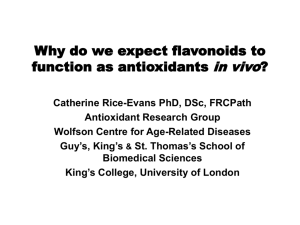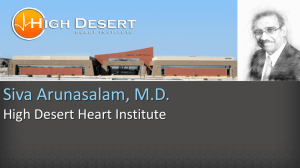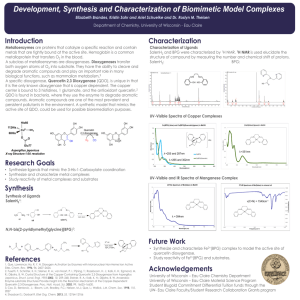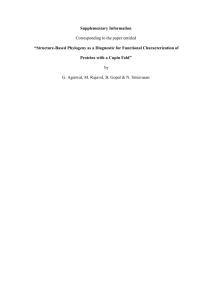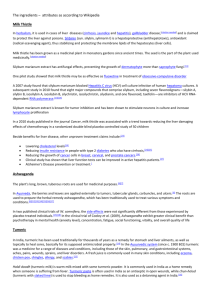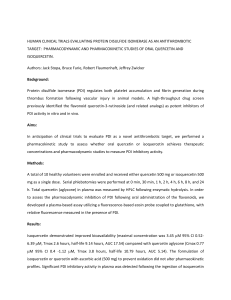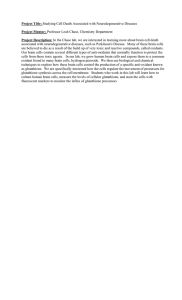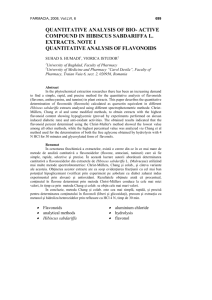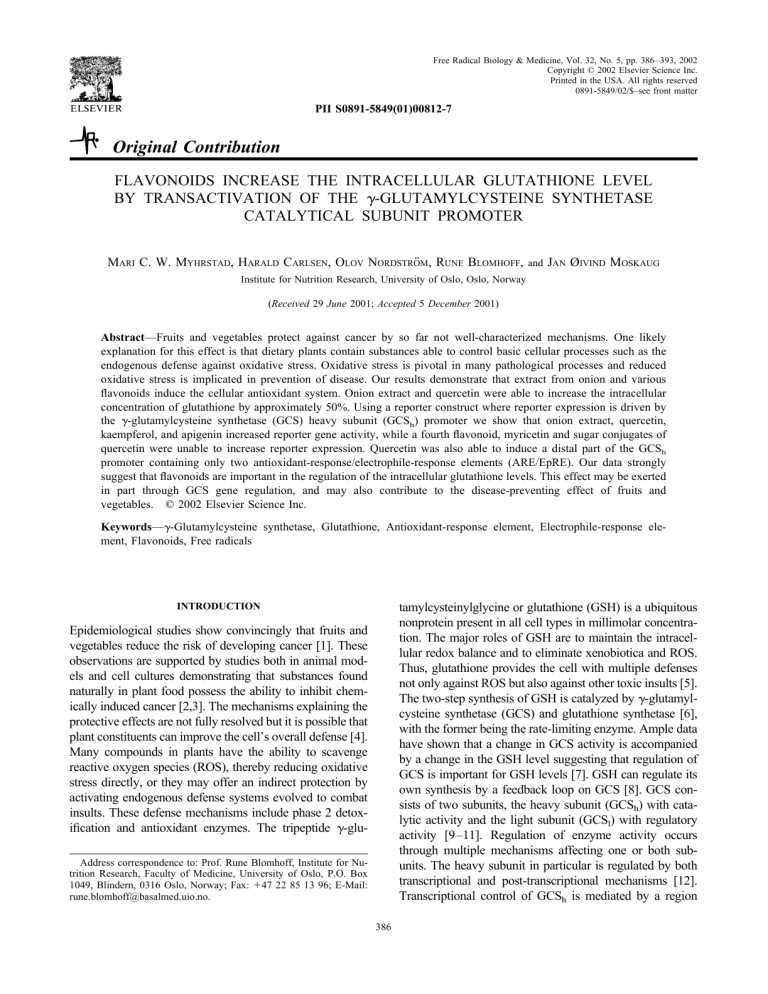
Free Radical Biology & Medicine, Vol. 32, No. 5, pp. 386 –393, 2002
Copyright © 2002 Elsevier Science Inc.
Printed in the USA. All rights reserved
0891-5849/02/$–see front matter
PII S0891-5849(01)00812-7
Original Contribution
FLAVONOIDS INCREASE THE INTRACELLULAR GLUTATHIONE LEVEL
BY TRANSACTIVATION OF THE ␥-GLUTAMYLCYSTEINE SYNTHETASE
CATALYTICAL SUBUNIT PROMOTER
MARI C. W. MYHRSTAD, HARALD CARLSEN, OLOV NORDSTRÖM, RUNE BLOMHOFF,
and JAN
ØIVIND MOSKAUG
Institute for Nutrition Research, University of Oslo, Oslo, Norway
(Received 29 June 2001; Accepted 5 December 2001)
Abstract—Fruits and vegetables protect against cancer by so far not well-characterized mechanisms. One likely
explanation for this effect is that dietary plants contain substances able to control basic cellular processes such as the
endogenous defense against oxidative stress. Oxidative stress is pivotal in many pathological processes and reduced
oxidative stress is implicated in prevention of disease. Our results demonstrate that extract from onion and various
flavonoids induce the cellular antioxidant system. Onion extract and quercetin were able to increase the intracellular
concentration of glutathione by approximately 50%. Using a reporter construct where reporter expression is driven by
the ␥-glutamylcysteine synthetase (GCS) heavy subunit (GCSh) promoter we show that onion extract, quercetin,
kaempferol, and apigenin increased reporter gene activity, while a fourth flavonoid, myricetin and sugar conjugates of
quercetin were unable to increase reporter expression. Quercetin was also able to induce a distal part of the GCSh
promoter containing only two antioxidant-response/electrophile-response elements (ARE/EpRE). Our data strongly
suggest that flavonoids are important in the regulation of the intracellular glutathione levels. This effect may be exerted
in part through GCS gene regulation, and may also contribute to the disease-preventing effect of fruits and
vegetables. © 2002 Elsevier Science Inc.
Keywords—␥-Glutamylcysteine synthetase, Glutathione, Antioxidant-response element, Electrophile-response element, Flavonoids, Free radicals
INTRODUCTION
tamylcysteinylglycine or glutathione (GSH) is a ubiquitous
nonprotein present in all cell types in millimolar concentration. The major roles of GSH are to maintain the intracellular redox balance and to eliminate xenobiotica and ROS.
Thus, glutathione provides the cell with multiple defenses
not only against ROS but also against other toxic insults [5].
The two-step synthesis of GSH is catalyzed by ␥-glutamylcysteine synthetase (GCS) and glutathione synthetase [6],
with the former being the rate-limiting enzyme. Ample data
have shown that a change in GCS activity is accompanied
by a change in the GSH level suggesting that regulation of
GCS is important for GSH levels [7]. GSH can regulate its
own synthesis by a feedback loop on GCS [8]. GCS consists of two subunits, the heavy subunit (GCSh) with catalytic activity and the light subunit (GCSl) with regulatory
activity [9 –11]. Regulation of enzyme activity occurs
through multiple mechanisms affecting one or both subunits. The heavy subunit in particular is regulated by both
transcriptional and post-transcriptional mechanisms [12].
Transcriptional control of GCSh is mediated by a region
Epidemiological studies show convincingly that fruits and
vegetables reduce the risk of developing cancer [1]. These
observations are supported by studies both in animal models and cell cultures demonstrating that substances found
naturally in plant food possess the ability to inhibit chemically induced cancer [2,3]. The mechanisms explaining the
protective effects are not fully resolved but it is possible that
plant constituents can improve the cell’s overall defense [4].
Many compounds in plants have the ability to scavenge
reactive oxygen species (ROS), thereby reducing oxidative
stress directly, or they may offer an indirect protection by
activating endogenous defense systems evolved to combat
insults. These defense mechanisms include phase 2 detoxification and antioxidant enzymes. The tripeptide ␥-gluAddress correspondence to: Prof. Rune Blomhoff, Institute for Nutrition Research, Faculty of Medicine, University of Oslo, P.O. Box
1049, Blindern, 0316 Oslo, Norway; Fax: ⫹47 22 85 13 96; E-Mail:
rune.blomhoff@basalmed.uio.no.
386
Flavonoids regulate the glutathione level
spanning approximately 5 kb of the 5⬘ flanking sequence of
the GCSh gene [13]. Analysis of this region has revealed the
presence of several response elements including AP-1 sites,
one NF-B site, one xenobiotic-response element (XRE),
and four antioxidant-response elements also called electrophile-response elements (ARE/EpRE). Nrf1 and Nrf2 are
transcription factors in the CNC bZIP family that binds to
ARE/EpRE elements and are implicated in the regulation of
GCS [14,15]. We have recently shown that overexpression
of Nrf1 led to an increase in the cellular glutathione level by
transcriptional upregulation of GCSh [16]. ARE/EpRE motifs are also found in promoters of other genes that participate in the defense against free radicals and toxic insults.
Among such genes are NADPH-quinone oxidoreductase
[17], glutathione S-transferase [18], UDP-glucuronosyl
transferase [19], thioredoxin [20], heme oxygenase-1 [21],
and ferritin [22]. Flavonoids are phenolic compounds and
comprise a large group of naturally occurring substances
found in all parts of the plant. Intake of flavonoids through
human diet varies, and is estimated to be in the range of
20 – 80 mg/day based on several independent studies [23].
Recent data shows that the naturally occurring flavonoid
quercetin is able to induce ARE/EpRE-dependent expression in MCF-7 cells, a human breast carcinoma cell line
[24].
In this study we have investigated the possible regulatory role of dietary flavonoids on the glutathione level
in COS-1 cells. The cells were incubated with either
crude extract from onion or pure flavonoids and assayed
for GSH content or transactivation of the GCSh promoter. A significant increase in GSH concentration was
observed with both extract and the flavonoid quercetin,
prompting us to investigate whether the increase was
mediated through increased expression of the genes coding for GCS. mRNA quantitation showed an increase in
both GCSh and GCSl transcripts. By transfecting COS-1
cells with a reporter construct containing the GCSh promoter, and subsequent treatment with quercetin,
kaempferol, apigenin, or onion extract, we could show
that all treatments increased reporter gene activity,
whereas a fourth flavonoid, myricetin, was unable to
increase the GCSh promoter activity. Quercetin was also
able to induce the expression of a reporter construct
containing the two distal ARE/EpRE elements of the
GCSh promoter.
MATERIALS AND METHODS
Cell culture
COS-1 cells, purchased from American Type Culture
Collection, were grown in Dulbecco’s modified Eagle’s
medium supplemented with 2 mM l-glutamine, 5
units/ml penicillin, 50 g/ml streptomycin (Sigma, St.
387
Louis, MO, USA), and 10% fetal calf serum (Integro
b.v.) (COS-1 medium). The cell cultures were contained
in a humidified atmosphere with 5% CO2 at 37°C. Lactate dehydrogenase (LDH) release was measured as control of toxicity according to the manufactures protocol
(Roche Diagnostics, Ottweiler, Germany). Cells were
examined microscopically for morphological changes after the different treatments.
Construction of plasmids
A reporter construct consisting of 3.8 kb of the GCSh
promoter in front of luciferase was kindly provided by
R. T. Mulcahy [13]. Briefly, a 4.2 kb fragment was
obtained from the 5⬘ flanking region of the human GCSh
gene and inserted into Hind III/Nco I sites of the pGL3
basic vector (Promega, Madison, WI, USA) resulting in
the ⫺3802/GCSh-luc. The distal GCSh-luc construct was
obtained by amplification of a 312 bp fragment containing ARE/EpRE3 and ARE/EpRE4 from human genomic
DNA by PCR (primers: 5⬘-ACT GCG GCA ATC CTA
GCA GC-3⬘ and 5⬘-AAG CTT CTG GAC CGT GGA
GAT CC-3⬘). The resulting fragment was cloned into the
pCR 2.1-TOPO vector from Invitrogen (Carlsbad, CA,
USA). This plasmid was digested with Hind III and the
resulting fragment was ligated into the Hind III site of a
TATA luc vector [25], resulting in the ⫺3258: ⫺2946/
GCSh-luc recombinant plasmid. The proximal GCSh-luc
construct was obtained by digestion of the recombinant
⫺3802/GCSh-luc plasmid with Sac I. The resulting 3217
bp fragment was isolated and religated to obtain the
recombinant -2752/GCSh-luc.
Transient transfection of COS-1 cells
The cells were plated in 35 mm tissue culture wells
the day before transfection at a density of approximately
60% confluence and transfected using a standard dextran-chloroquin method as described previously [26]
with 0.7 g DNA in each well. The cells were subjected
to a DMSO shock (Sigma, St. Louis, MO, USA) (10% in
PBS), after which they were incubated overnight in
COS-1 medium. At the conclusion of this incubation
period the medium was replaced with fresh COS-1 medium containing either DMSO or onion extract, quercetin, quercetin-3-glucoside, quercetin-3-rhamnoglucoside,
kaempferol, myricetin, apigenin dissolved in DMSO.
The flavonoids were purchased from Sigma.
Luciferase measurements
Luciferase activity was measured in cell lysates according to the manufacturers protocol (Promega).
388
M. C. W. MYHRSTAD et al.
Briefly, the cells were washed in PBS without Ca2⫹ or
Mg2⫹ prior to the addition of 300 l lysis buffer. The
cells were incubated at room temperature for 20 min
before collection by scraping and subsequent lysis by
vigorous vortexing. The lysate was then briefly centrifuged to remove cell debris. Luciferase activity was
measured by adding 100 l luciferase assay solution to
20 l of the lysate and luminescence was detected in a
TD 20/20 luminometer (Turner Design, Sunnyvale, CA,
USA). Protein concentration was measured in the cell
lysate using Coomassie brilliant blue reagent from BioRad Laboratories (Hercules, CA, USA).
Onion extraction
The three outer layers of onions were homogenized
and lyophilized. One gram of dry material was extracted
overnight at 4°C in 20 ml 70% methanol. The extract was
filtered through a 0.5 m Millipore filter type FH (Millipore, Waltham, MA, USA). The filtrate was concentrated by evaporation to a volume of 500 l and diluted
with 500 l 100% DMSO (1 g freeze-dried onion/ml).
From this stock solution various volumes were added to
cell cultures in the experiments as indicated.
Glutathione measurements
Cells were harvested in a sodium phosphate buffer (10
mM, pH 6) containing 10 M EDTA (Sigma) and thereafter lysed by several freeze-thaw cycles. Proteins were
precipitated with approximately 2% TFA, and the resulting
supernatant was neutralized to pH 2 with 1 M KOH. GSH
and GSSG were analyzed on a HPLC system (Hewlett
Packard 1100 system) equipped with a dual electrochemical
detector, Coulochem II (ESA Inc., Chelmsford, MA, USA),
Model 5500, with an ESA detector cell model 5010 and a
5020 guard cell, both with inline filters. The guard cell was
set to 900 mV and the analytical cells to 770 and 900 mV.
Data was collected and analyzed with HP Chem Station
software. A dampener (LabAlliance, model LP-21, State
College, PA, USA) was placed between the pump and the
injector. Chromatography was performed on a Hypersil
ODS column (150 ⫻ 4.6 mm I.D. with 3 m particle size)
with ODS precolumn (2 cm, Supelco, Bellefonte, PA,
USA) placed before the separation column. The elution was
isocratic with a mobile phase consisting of 40 mM
NaH2PO4 (AnalaR, BDH Limited, Poole, England), 100
M sodium octane sulfonic acid (Sigma), which was adjusted to pH 2.7 with 85% phosphoric acid and acetonitrile
(Rathburn, Walkerburn, Scotland) in a ratio of 49/1. GSH
and GSSG (Sigma) stock solution (1 mg/ml) used for standardization was made weekly in mobile phase containing 1
mM EDTA. Standard curves were made daily in the range
of 30 – 650 M in the same buffer used for analyses of cell
lysates. The injection volume was 10 l for all analyses.
Peaks were identified by retention times and by spiking
samples with GSH or GSSG. GSH in cells treated with
actinomycin D (Sigma) was measured using the Bioxytech
GSH-400 kit from Oxis Research (Portland, OR, USA)
according to the manufacturer’s protocol.
Quantitative mRNA analysis
The cells were plated in 35 mm tissue culture wells 2 d
before mRNA isolation at a density of approximately 60%
confluence. mRNA was isolated by oligo (dT)16 beads
according to the manufacturers protocol (Genovision, Oslo,
Norway). mRNA was eluted from the beads in 20 l
DEPC-treated water and cDNA synthesis was performed
with Omniscript kit (Qiagen, Hilden, Germany) according
to the manufacturer’s instructions. cDNA from each sample
was analyzed by PCR amplification using LightCycler
(Roche Diagnostics, Ottweiler, Germany) with Fast Start
DNA Master Sybrgreen I kit (Roche Diagnostics). The
PCR conditions were 4 mM MgCl2 for GCSh and GCSl or
3 mM MgCl2 for -actin, 10 pmol of each PCR primer
(GCSh primers: 5⬘-AGA GAA GGG GGA AAG GAC
AA-3⬘ and 5⬘-GTG AAC CCA GGA CAG CCT AA-3,
GCSl primers: 5⬘-TCA GTC CTT GGA GTT GCA CA-3⬘
and 5⬘-AAA TCT GGT GGC ATC ACA CA-3⬘, -actin
primers: 5⬘-TCG TGC GTG ACA TTA AGG AG-3⬘ and
5⬘-AGC ACT GTG TTG GCG TAC AG-3⬘), 2 l of
LightCycler DNA Master mix, and cDNA to a final volume
of 20 l. After 10 min preincubation at 95°C, 45 PCR
cycles were performed with 15 s denaturation at 95°C, 5 s
annealing at 55 (GCSh,) or 60 (-actin) °C, and 12 s
extension at 72°C. cDNA obtained by RT-PCR of GCSl,
GCSh, and -actin was cloned into a pCR 2.1-TOPO vector
(Invitrogen, Carlsbad, CA, USA) to obtain a standard plasmid used to calculate the number of cDNA copies in a
sample. After amplification, data analyses were performed
using the second derivative maximum method. The second
derivative maximum values were used to plot cycle number
versus log concentration of the standard plasmid. The actual
number of GCSh and GCSl cDNA copies was related to that
of -actin in each sample. Contamination of mRNA samples with genomic DNA was ruled out by omitting the
reverse transcriptase in control reactions. The identity of the
PCR products was confirmed by melting curve analyses and
size determination.
Statistical analysis
Statistical analysis was carried out using Student’s
t-test for unpaired two-tailed comparisons; p values less
than .05 were considered significant.
Flavonoids regulate the glutathione level
389
Table 1. LDH Release as a Measure of Loss of Membrane Integrity
Treatment
Triton X-100 (2%)
DMSO (0.1%)
Quercetin 5 M
Quercetin 25 M
% LDH-release
100
5.24 ⫾ 3.03
5.13 ⫾ 0.45
2.41 ⫾ 0.16
LDH was measured 17 h after incubation with the indicated reagent.
Quercetin was dissolved in DMSO and added to the cells in a final
DMSO concentration of 0.1%. LDH release is expressed as % of the
value measured in Triton X-100 (2%) treated cells. Data are presented
as mean of values ⫾ SD (n ⫽ 6).
level. Five and 25 M quercetin significantly increased
the GSH level by 34 and 51%, respectively (Fig. 1B).
The level of oxidized glutathione (GSSG) constituted
less than 0.2% of GSH both in untreated cells and in cells
treated with concentrations of quercetin up to 50 M
(Fig. 1C). To rule out cytotoxic effects of quercetin we
measured LDH release from the COS-1 cells after quercetin treatment. Five or 25 M quercetin did not significantly influence LDH release as compared with DMSOtreated control cells (Table 1).
mRNA of GCSh and GCSl are increased in COS-1 cells
incubated with quercetin
Fig. 1. Effect of onion extract and quercetin on GSH levels in COS-1
cells. COS-1 cells were treated with an extract containing 2 mg freezedried onion per ml medium (A) or increasing concentrations of quercetin (B) for 24 h. The cells were thereafter lysed by several freezethaw cycles. Proteins were precipitated and the resulting supernatant
was analyzed for GSH and GSSG concentrations on a HPLC system.
The amount of GSH and GSSG was related to the protein concentration
in each sample. Data is given as % GSH related to that of control (0.1%
DMSO) or as % GSSG of GSH (C). The mean values ⫾ SD are
presented. * p ⬍ .05 (n ⫽ 6).
To determine at what stage substances in plant extract
exert their GSH increasing activity, mRNA levels of GCSh
and GCSl were analyzed by quantitative RT-PCR after
incubating cells with 5 and 25 M quercetin for 17 h. The
mRNA levels of both GCSh and GCSl were increased
dose-dependently reaching a 2-fold increase with 25 M
quercetin (Fig. 2), suggesting that the increase in the glu-
RESULTS
Glutathione levels are increased in COS-1 cells
incubated with onion extract or quercetin
To test the hypothesis that dietary flavonoids increase
cellular endogenous antioxidants, COS-1 cells were
treated with an extract of yellow onion known to contain
high concentrations of flavonoids [27]. Exposing the
cells to an extract containing 2 mg freeze-dried onion per
ml medium for 24 h resulted in a 47% increase in the
GSH level (Fig. 1A). Since the main flavonoid found in
onion is quercetin (0.3 mg/g fresh weight) [28], we tested
if this flavonoid could also increase the intracellular GSH
Fig. 2. Effect of quercetin on GCSl and GCSh mRNA levels. COS-1
cells were incubated with 5 M quercetin (white bars) or 25 M
quercetin (gray bars) for 17 h using 0.1% DMSO (black bars) as
control. The cells were harvested and quantitative RT-PCR was performed as described in Materials and Methods. The mRNA level of
GCSh or GCSl is related to the mRNA level of -actin in each sample.
The results are given as fold increase compared to control levels and
represent the mean values ⫾ SD. * p ⬍ .05 (n ⫽ 8).
390
M. C. W. MYHRSTAD et al.
tathione level by quercetin is mediated by transcriptional
induction of both GCSl and GCSh mRNA. To confirm this,
we incubated COS-1 cells with 5 or 25 M quercetin in the
absence or presence of 1 g/ml actinomycin D. We observed no increase in the cellular GSH levels in the presence
of actinomycin D (data not shown).
The complete promoter of GCSh is induced in COS-1
cells incubated with various flavonoids or onion
extract
To demonstrate that onion extract transactivated the
GCSh promoter, extracts at various concentrations were
added to COS-1 cells transfected with a luciferase reporter construct controlled by the 3.8 kb 5⬘ region of the
GCSh gene (⫺3802/GCSh-luc, Fig. 5). Figure 3A shows
that various extracts ranging from 0.5 to 2 mg freeze
dried onion per ml medium induced the GCSh promoter
activity in a concentration-dependent manner after 17 h
incubation. The highest induction (2.7-fold increase) was
found with 2 mg/ml onion extract while 0.5 and 1 mg/ml
extract gave 1.7- and 2-fold increase in luciferase activity
compared to control, respectively.
We then added quercetin to COS-1 cells transfected
with the GCSh promoter luciferase construct to explore
whether the effect of quercetin on the mRNA level of
GCSh was due to transactivation of the GCSh promoter.
After a 20 h post-transfection recovery period the cells
were incubated with 5–75 M quercetin for 17 h. The
highest inductions were measured after exposing the
cells to 25 and 50 M quercetin (4.5- to 5-fold) while at
the highest concentration (75 M) a slightly lower induction was observed (4-fold). The lowest induction was
observed with 5 M (1.7-fold increase) (Fig. 3B). This is
in line with the observed induction of GCSh mRNA at 5
M quercetin, as measured by quantitative RT-PCR
(Fig. 2). The human cell lines HepG2 and Jurkat were
also subjected to treatment with quercetin under similar
conditions as COS-1 cells. In both of these cell lines
quercetin induced reporter gene activity to nearly the
same extent as in COS-1 cells (data not shown). To rule
out transactivation by quercetin-mediated hydrogen peroxide production in the cell medium, we incubated transfected cells with up to 250 M hydrogen peroxide before
measuring luciferase activity in cell homogenates. No
increase in luciferase activity was observed after incubation of cells with hydrogen peroxide under the conditions
used (data not shown).
In fruits and vegetables flavonoids are conjugated to
sugar residues and are thus ingested in this form. We
wanted to investigate whether quercetin containing sugar
moieties also induced the GCSh promoter in COS-1 cells.
The two derivates of quercetin, quercetin-3-glucoside or
quercetin-3-rhamnoglucoside (5 or 25 M), were added
Fig. 3. Induction of GCSh promoter by quercetin and onion extract in
COS-1 cells. COS-1 cells transiently transfected with GCSh luc were
incubated with onion extracts (A, n ⫽ 9) increasing concentrations of
quercetin (B, n ⫽ 3) or quercetin derivatives (C, n ⫽ 6) for 17 h. The
cells were thereafter washed in PBS, lysed, and cell lysates were
collected and luciferase activity was measured. Luciferase activity was
related to protein concentrations in each well. Data is given as fold
increase related to that of 0.1% DMSO (control) and the mean values ⫾
SD are presented.
to COS-1 cells transfected with the reporter construct.
The two quercetin conjugates had no effect on the GCSh
promoter activity, whereas the aglycone form of quercetin potently induced luciferase activity through the GCSh
promoter, as shown in Fig. 3C.
To investigate whether flavonoids in general can activate
the GCSh promoter we incubated COS-1 cells with four of
the most common flavonoids in dietary plants, namely
quercetin, kaempferol, myricetin, and apigenin. Quercetin
Flavonoids regulate the glutathione level
Fig. 4. Induction of GCSh by various flavonoids in COS-1 cells. COS-1
cells transiently transfected with the complete GCSh luc were incubated
with either 25 M of quercetin (n ⫽ 12), kaempferol (n ⫽ 9), or
myricetin (n ⫽ 9) or 10 M apigenin (n ⫽ 9) for 17 h. The cells were
thereafter washed in PBS, lysed, and scraped from the wells. Cell
lysates were collected and luciferase activity was measured. Luciferase
activity was related to protein concentrations in each well. Data is given
as fold increase related to that of 0.1% DMSO (control) and each bar
graph represent the mean value ⫾ SD. * p ⬍ .05.
(25 M), kaempferol (25 M), and apigenin (10 M)
induced luciferase activity 3-fold, 2.2-fold, and 1.8-fold,
respectively after 17 h of incubation (Fig. 4). Apigenin was
toxic to the cells when added at concentrations higher than
10 M as measured by release of LDH (data not shown).
Myricetin treatment of transfected cells had no effect on
transcription of the reporter construct.
Quercetin induce both distal and proximal parts of the
GCSh promoter
As outlined in Fig. 5A, the 3.8 kb GCSh promoter
contains several response elements that could mediate
transactivation by the different flavonoids. These include 4
391
ARE/EpRE motifs, two located at the distal end of the
promoter (ARE/EpRE3 and 4) and two located at the more
proximal end (ARE/EpRE1 and 2). ARE/EpRE3 and 4
perfectly match the consensus ARE/EpRE sequence as defined by Nguyen and Pickett [29] while ARE/EpRE1 and 2
show differences in the first and the last position, respectively. To determine the part of the promoter through which
the quercetin exerts its effect, we constructed reporter plasmids where luciferase are either driven by the 5⬘ flanking
region of GCSh spanning from ⫺3258 to ⫺2946 (ARE/
EpRE3 and 4, Fig. 5) or ⫺2752 to ⫺1 (ARE/EpRE1 and 2,
Fig. 5). Quercetin was thereafter tested for its ability to
induce the expression of luciferase from the two constructs.
As shown in Fig. 5, quercetin induced both the distal and
the proximal part of the promoter. The induction of luciferase activity by quercetin was, however, higher when cells
were transfected with a construct containing the 3.8 kb
promoter, suggesting that the different promoter elements
operate together.
DISCUSSION
In a recent study quercetin and other flavonoids were
found to efficiently protect neuronal cells from oxidative
glutamate toxicity and other forms of oxidative injury.
Interestingly, increasing the production of GSH was one of
three mechanisms suggested by the authors for the protective effects of quercetin [30]. In our study using COS-1
cells we show that indeed quercetin elevates the GSH level
and the expression of both the regulatory and the catalytical
subunit of GCS. In addition we find that quercetin potently
transactivates the GCSh promoter. Thus, our data strongly
suggest that the elevation of GSH by flavonoids is due to an
increased synthesis of GCS. The activity of GCS is regu-
Fig. 5. Induction of complete-, proximal-, or distal-GCSh promoter by quercetin. COS-1 cells transiently transfected with the complete
GCSh luc (black bar, n ⫽ 12), proximal GCSh (white bar, n ⫽ 15) or distal GCSh (gray bar, n ⫽ 10) were incubated with 25 M
quercetin for 17 h. The cells were thereafter washed in PBS, lysed, and scraped from the wells. Cell lysates were collected and
luciferase activity was measured. Luciferase activity was related to protein concentrations in each well. Data is given as fold increase
related to that of 0.1% DMSO (control) and each bar graph represent the mean value ⫾ SD.
392
M. C. W. MYHRSTAD et al.
lated both at the transcriptional and post-transcriptional
level, including post-translational regulation. Thus, the
overall regulation related to transcriptional regulation of
GCSh as described in the present work is not clear. The
nonlinear relationship between GCSh promoter transactivation, GCSh mRNA levels, and GSH suggest that indeed
other regulatory mechanisms also contribute to the observed GSH regulation. The ability to regulate GSH production may be one of the mechanisms cells have evolved
to mount a defense against various stress conditions, since
GSH can act as versatile compound in the combat against a
battery of different insults [31].
Flavonoids are usually present in plant food as sugarconjugates. Neither quercetin-3-glucoside nor quercetin-3rhamnoglucoside (rutin) were able to activate gene transcription through GCSh promoter (Fig. 3D) in our
experiments. This indicates that the transcriptional active
compound is the aglycone form of the flavonoids, or that
the cell did not efficiently take up the sugar-conjugates of
quercetin. It has been suggested that quercetin-glucosides is
taken up through a Na-dependent glucose transport [32]. As
our experiments are carried out in medium with high glucose it is possible that uptake of quercetin-glucosides is
competed out with glucose. Alternatively, quercetin is rendered more hydrophilic by the sugar moieties and thus has
less potential to passively diffuse across the cell membrane.
Quercetin was recently shown to activate the promoter of
NADPH-quinone oxidoreductase through ARE/EpRE-dependent mechanisms [24]. This observation together with
our results strongly indicates that dietary flavonoids can
stimulate transcription of antioxidant and detoxification defense systems through ARE elements. The observation that
different flavonoids induced the reporter with different efficiency suggests that induction through ARE/EpRE distinguish between subtle differences in flavonoids structure.
Also, Ishige and co-workers observed differences in the
ability of flavonoids to regulate cellular GSH content. Quercetin and fisetin increased the total GSH level, whereas
kaempferol and luteolin did not [30]. The structure-activity
relationships may be related to their antioxidant capacity or
to their potential function as ligands for hitherto unknown
receptors. Alternatively, the flavonoids may be able to influence an intracellular sensor protein, Keap1. Keap1 is
critical in transcriptional activation of proteins participating
in cellular defense [31,33]. It has been shown that Keap1
sequesters Nrf2 in the cytosol, preventing it from ARE/
EpRE-dependent transactivation [33]. We speculate that
flavonoids are able to modify the interaction between
Keap1 and Nrf2, thereby releasing Nrf2, which can translocate into the nucleus and transactivate the GCSh promoter. The nature of the Keap1 Nrf2 interaction is still not
clear.
Dinkova-Kostova et al. have made further advances by
providing evidence that the potencies for phase 2 enzyme
induction, increase in cellular GSH levels, and thiol reactivity are closely related [34]. Flavonoids have been shown
to react with sulfhydryl groups [35], supporting the hypothesis that flavonoids can modulate one or several sensor
protein(s), of which Keap1 could be a member. Further
experiments are needed to explore these possibilities.
Induction of expression of protective enzymes may be
an important aspect of the chemopreventive effects of fruits
and vegetables. Chemopreventive agents that enhance the
cellular capacity to combat oxidative stress have been
shown to inhibit chemically induced carcinogenesis in animal models [36–38]. Humans ingest approximately 1 g/d
of polyphenols, of which 20– 80 mg are flavonoids [39].
Ingested flavonoids are then extensively metabolized both
in the small intestine and after eventual absorption. We
obtained GSH induction with only the aglycone of quercetin, suggesting that the cells most efficiently take up this
form of quercetin. Whether quercetin exerts its effect on the
GCSh promoter before or after conversion to another flavonoid or conjugation cannot be determined from our experiments. However, the results suggest that even if quercetin-glucoside may be absorbed in the intestine it does not
transactivate GCSh. The use of purified compounds in experimental systems may provide insight into chemoprevention, however, the human body has adapted to a high intake
of naturally occurring phenolic compounds. Chemoprevention is therefore most likely to succeed with recommendation of a high intake of fruits and vegetables.
Acknowledgements — This work was supported by grants from the
Norwegian Research Council, Norwegian Cancer Society and The
Johan Throne Holst Nutrition Research Foundation. We thank Professor Mulcahy for the kind gift of the construct containing the complete
GCSh-promoter. We also want to thank Hege Hardersen for excellent
technical assistance.
REFERENCES
[1] Glade, M. J. Food, nutrition, and the prevention of cancer: a
global perspective. American Institute for Cancer Research/World
Cancer Research Fund, American Institute for Cancer Research,
1997. Nutrition 15:523–526; 1999.
[2] Wattenberg, L. W. An overview of chemoprevention: current
status and future prospects. Proc. Soc. Exp. Biol. Med. 216:133–
141; 1997.
[3] Fahey, J. W.; Zhang, Y.; Talalay, P. Broccoli sprouts: an exceptionally rich source of inducers of enzymes that protect against
chemical carcinogens. Proc. Natl. Acad. Sci. USA 94:10367–
10372; 1997.
[4] Wilkinson, J. T.; Clapper, M. L. Detoxication enzymes and chemoprevention. Proc. Soc. Exp. Biol. Med. 216:192–200; 1997.
[5] Hayes, J. D.; Ellis, E. M.; Neal, G. E.; Harrison, D. J.; Manson,
M. M. Cellular response to cancer chemopreventive agents: contribution of the antioxidant responsive element to the adaptive
response to oxidative and chemical stress. Biochem. Soc. Symp.
64:141–168; 1999.
[6] Anderson, M. E. Glutathione: an overview of biosynthesis and
modulation. Chem. Biol. Interact. 111–112:1–14; 1998.
[7] Morales, A.; Garcia-Ruiz, C.; Miranda, M.; Mari, M.; Colell, A.;
Ardite, E.; Fernandez-Checa, J. C. Tumor necrosis factor increases hepatocellular glutathione by transcriptional regulation of
the heavy subunit chain of gamma-glutamylcysteine synthetase.
J. Biol. Chem. 272:30371–30379; 1997.
Flavonoids regulate the glutathione level
[8] Richman, P. G.; Meister, A. Regulation of gamma-glutamylcysteine synthetase by nonallosteric feedback inhibition by glutathione. J. Biol. Chem. 250:1422–1426; 1975.
[9] Yan, N.; Meister, A. Amino acid sequence of rat kidney gammaglutamylcysteine synthetase. J. Biol. Chem. 265:1588 –1593; 1990.
[10] Huang, C. S.; Anderson, M. E.; Meister, A. Amino acid sequence
and function of the light subunit of rat kidney gamma-glutamylcysteine synthetase. J. Biol. Chem. 268:20578 –20583; 1993.
[11] Huang, C. S.; Chang, L. S.; Anderson, M. E.; Meister, A. Catalytic and regulatory properties of the heavy subunit of rat kidney
gamma-glutamylcysteine synthetase. J. Biol. Chem. 268:19675–
19680; 1993.
[12] Lu, S. C. Regulation of hepatic glutathione synthesis: current
concepts and controversies. FASEB J. 13:1169 –1183; 1999.
[13] Mulcahy, R. T.; Wartman, M. A.; Bailey, H. H.; Gipp, J. J.
Constitutive and beta-naphthoflavone-induced expression of the
human gamma-glutamylcysteine synthetase heavy subunit gene is
regulated by a distal antioxidant response element/TRE sequence.
J. Biol. Chem. 272:7445–7454; 1997.
[14] Kwong, M.; Kan, Y. W.; Chan, J. Y. The CNC basic leucine
zipper factor, Nrf1, is essential for cell survival in response to
oxidative stress-inducing agents. Role for Nrf1 in gamma-gcs(l)
and gss expression in mouse fibroblasts. J. Biol. Chem. 274:
37491–37498; 1999.
[15] Chan, J. Y.; Kwong, M. Impaired expression of glutathione synthetic
enzyme genes in mice with targeted deletion of the Nrf2 basicleucine zipper protein. Biochim. Biophys. Acta 1517:19 –26; 2000.
[16] Myhrstad, M. C.; Husberg, C.; Murphy, P.; Nordstrom, O.; Blomhoff, R.; Moskaug, J. O.; Kolsto, A. B. TCF11/Nrf1 overexpression increases the intracellular glutathione level and can transactivate the gamma-glutamylcysteine synthetase (GCS) heavy
subunit promoter. Biochim. Biophys. Acta 1517:212–219; 2001.
[17] Favreau, L. V.; Pickett, C. B. Transcriptional regulation of the rat
NAD(P)H:quinone reductase gene. Identification of regulatory
elements controlling basal level expression and inducible expression by planar aromatic compounds and phenolic antioxidants.
J. Biol. Chem. 266:4556 – 4561; 1991.
[18] Rushmore, T. H.; King, R. G.; Paulson, K. E.; Pickett, C. B.
Regulation of glutathione S-transferase Ya subunit gene expression: identification of a unique xenobiotic-responsive element
controlling inducible expression by planar aromatic compounds.
Proc. Natl. Acad. Sci. USA 87:3826 –3830; 1990.
[19] Prestera, T.; Talalay, P.; Alam, J.; Ahn, Y. I.; Lee, P. J.; Choi,
A. M. Parallel induction of heme oxygenase-1 and chemoprotective phase 2 enzymes by electrophiles and antioxidants: regulation
by upstream antioxidant-responsive elements (ARE). Mol. Med.
1:827– 837; 1995.
[20] Kim, Y. C.; Masutani, H.; Yamaguchi, Y.; Itoh, K.; Yamamoto,
M.; Yodoi, J. Hemin-induced activation of the thioredoxin gene
by Nrf2. A differential regulation of the antioxidant responsive
element (ARE) by switch of its binding factors. J. Biol. Chem.
276:18399 –18406; 2001.
[21] Inamdar, N. M.; Ahn, Y. I.; Alam, J. The heme-responsive element of the mouse heme oxygenase-1 gene is an extended AP-1
binding site that resembles the recognition sequences for MAF
and NF-E2 transcription factors. Biochem. Biophys. Res. Commun. 221:570 –576; 1996.
[22] Tsuji, Y.; Ayaki, H.; Whitman, S. P.; Morrow, C. S.; Torti, S. V.;
Torti, F. M. Coordinate transcriptional and translational regulation of ferritin in response to oxidative stress. Mol. Cell. Biol.
20:5818 –5827; 2000.
[23] Bravo, L. Polyphenols: chemistry, dietary sources, metabolism,
and nutritional significance. Nutr. Rev. 56:317–333; 1998.
[24] Valerio, L. G. Jr.; Kepa, J. K.; Pickwell, G. V.; Quattrochi, L. C.
Induction of human NAD(P)H:quinone oxidoreductase (NQO1)
gene expression by the flavonol quercetin. Toxicol. Lett. 119:49 –
57; 2001.
[25] Lernbecher, T.; Muller, U.; Wirth, T. Distinct NF-kappa B/Rel
transcription factors are responsible for tissue-specific and inducible gene activation. Nature 365:767–770; 1993.
393
[26] Natarajan, V.; Holven, K. B.; Reppe, S.; Blomhoff, R.; Moskaug,
J. O. The C-terminal RNLL sequence of the plasma retinolbinding protein is not responsible for its intracellular retention.
Biochem. Biophys. Res. Commun. 221:374 –379; 1996.
[27] Scalbert, A.; Williamson, G. Dietary intake and bioavailability of
polyphenols. J. Nutr. 130:2073S–2085S; 2000.
[28] Hertog, M. G.; Feskens, E. J.; Hollman, P. C.; Katan, M. B.; Kromhout, D. Dietary antioxidant flavonoids and risk of coronary heart
disease: the Zutphen Elderly Study. Lancet 342:1007–1011; 1993.
[29] Nguyen, T.; Pickett, C. B. Regulation of rat glutathione S-transferase
Ya subunit gene expression. DNA-protein interaction at the antioxidant responsive element. J. Biol. Chem. 267:13535–13539; 1992.
[30] Ishige, K.; Schubert, D.; Sagara, Y. Flavonoids protect neuronal
cells from oxidative stress by three distinct mechanisms. Free
Radic. Biol. Med. 30:433– 446; 2001.
[31] Hayes, J. D.; McLellan, L. I. Glutathione and glutathione-dependent enzymes represent a co-ordinately regulated defence against
oxidative stress. Free Radic. Res. 31:273–300; 1999.
[32] Walgren, R. A.; Lin, J. T.; Kinne, R. K.; Walle, T. Cellular uptake
of dietary flavonoid quercetin 4⬘-beta-glucoside by sodium-dependent glucose transporter SGLT1. J. Pharmacol. Exp. Ther.
294:837– 843; 2000.
[33] Itoh, K.; Wakabayashi, N.; Katoh, Y.; Ishii, T.; Igarashi, K.;
Engel, J. D.; Yamamoto, M. Keap1 represses nuclear activation of
antioxidant responsive elements by Nrf2 through binding to the
amino-terminal Neh2 domain. Genes Dev. 13:76 – 86; 1999.
[34] Dinkova-Kostova, A. T.; Massiah, M. A.; Bozak, R. E.; Hicks,
R. J.; Talalay, P. From the Cover: Potency of Michael reaction
acceptors as inducers of enzymes that protect against carcinogenesis depends on their reactivity with sulfhydryl groups. Proc.
Natl. Acad. Sci. USA 98:3404 –3409; 2001.
[35] Galati, G.; Moridani, M. Y.; Chan, T. S.; O’Brien, P. J. Peroxidative metabolism of apigenin and naringenin versus luteolin and
quercetin: glutathione oxidation and conjugation. Free Radic.
Biol. Med. 30:370 –382; 2001.
[36] Benson, A. M.; Batzinger, R. P.; Ou, S. Y.; Bueding, E.; Cha, Y. N.;
Talalay, P. Elevation of hepatic glutathione S-transferase activities
and protection against mutagenic metabolites of benzo(a)pyrene by
dietary antioxidants. Cancer Res. 38:4486 – 4495; 1978.
[37] Pantuck, E. J.; Pantuck, C. B.; Garland, W. A.; Min, B. H.;
Wattenberg, L. W.; Anderson, K. E.; Kappas, A.; Conney, A. H.
Stimulatory effect of brussels sprouts and cabbage on human drug
metabolism. Clin. Pharmacol. Ther. 25:88 –95; 1979.
[38] Wattenberg, L. W. Chemoprevention of cancer. Cancer Res.
45:1– 8; 1985.
[39] Hertog, M. G.; Kromhout, D.; Aravanis, C.; Blackburn, H.;
Buzina, R.; Fidanza, F.; Giampaoli, S.; Jansen, A.; Menotti, A.;
Nedeljkovic, S.; Pekkannen, M.; Simic, B. S.; Toshima, H.;
Feskens, E. J.; Hollman, P. C.; Katan, M. B. Flavonoid intake and
long-term risk of coronary heart disease and cancer in the seven
countries study. Arch. Intern. Med. 155:381–386; 1995.
ABBREVIATIONS
ARE/EpRE—antioxidant-response element/electrophileresponse element
DMSO— dimetyl sulfoxide
GCS—␥-glutamylcysteine synthetase
GSH— glutathione
GSSG— oxidized glutathione
LDH—lactate dehydrogenase
ROS—reactive oxygen species
RT-PCR—reverse transcriptase PCR
TFA—trifluoroacetic acid
XRE—xenobiotica-response element

